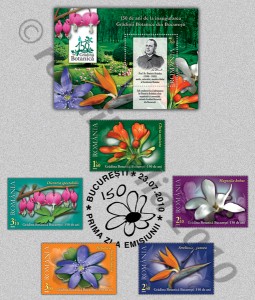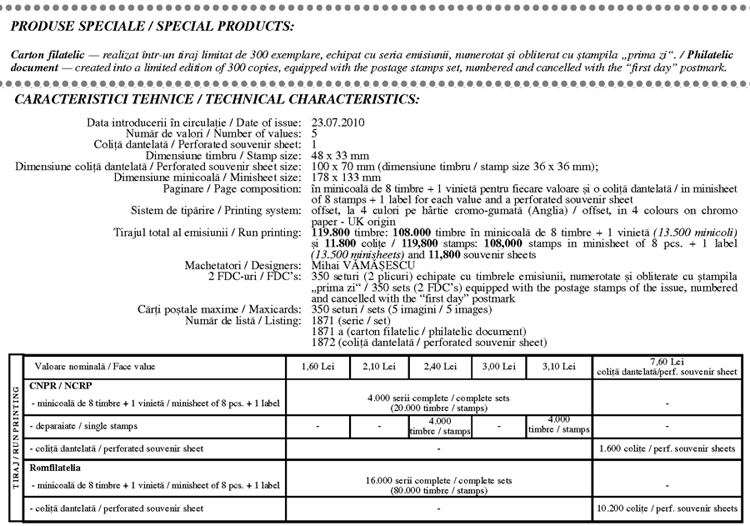 This year, on the 150th anniversary of the Botanical Garden of Bucharest, Romfilatelia introduces into circulation this postage stamps issue.This year, on the 150th anniversary of the Botanical Garden of Bucharest, Romfilatelia introduces into circulation this postage stamps issue.
This year, on the 150th anniversary of the Botanical Garden of Bucharest, Romfilatelia introduces into circulation this postage stamps issue.This year, on the 150th anniversary of the Botanical Garden of Bucharest, Romfilatelia introduces into circulation this postage stamps issue.
Set up as an institution in 1860 by Doctor Carol Davila on a 7 hectares land, donated by the Ruler Alexandru Ioan Cuza, the Botanical Garden was built by Dimitrie Brandza Ph. D, on the present ground, near Cotroceni Palace, starting with 1884.
Until 1884, Dimitrie Grecescu Ph. D. and the botanist Ulrich Hoffman contributed directly to the arrangement of green spaces and collections, found in the first plants catalogue published in Romania which included 3700 species of plants, cultivated in open space and in the greenhouses.
The Romanian doctor, naturalist and botanist, Dimitrie Brandza, together with the landscape painter and architect Louis Fuchs, achieved a complete arrangement which included the greenhouses, the building of the Botanical Garden, all of them placed on the ground where they planted the first trees and shrubs. The arrangement and organization project of the Botanical Garden of Bucharest was completed in 1891.
After several damages provoked by floods (1892), by the German troops camped on its ground during the World War I and by the Anglo – American bombing in April 1944, the Botanical Garden was included in a major arrangement and modernization project.
Starting with 1954, the management of the Botanical Garden is entrusted to the University of Bucharest, under whose guidance they started building new greenhouses, a new headquarters of the Botanical Institute (1960), a General Herbarium, a complex of greenhouses for exhibition (1976), and a new Botanical Museum (1978).
In 1994, the Botanical Garden from Bucharest was named after Dimitrie Brandza, Ph. D.
Today, the Botanical Garden of Bucharest represents an important center of plants diversity preservation, scientific research and education, but also a real environmental education center.
On the postage stamp with the face value of RON 1.60 it is illustrated Clivia miniata (Lindley) Regel. It is also called Kaffir lily. It is an herbaceous plant from South Africa, with arched, long (40-50 cm) and lanceolate leaves, like wide belts arranged under the shape of a fan on a short body. Clivia miniata impresses by its very special intense orange, red-orange or yellow colored flowers. Their appearance resembles a horn or a trumpet, grouped into an umbrella inflorescence on top of a long and rigid stalk, above the leaves. They usually bloom in midwinter.
On the stamp with the face value of RON 2.10 it is illustrated Magnolia kobus DC. (Kobushi magnolia). It is an ornamental thermophilic shrub from Japan, cultivated in parks and gardens. It blooms abundantly in early spring before leafing out. Flowers are white and big, exceeding 10 cm in diameter when completely blossomed. Its leaves have an obovat shape arranged alternately on the side branches and thin bines.
On the postage stamp with the face value of RON 2.40 it is illustrated Strelitzia juncea Link or Bird of Paradise. It is an herbaceous perennial 1-2 meter height plant from South Africa, with long floriferous stems and spectacular orange or yellow flowers. It is an indoor ornamental plant with a long blooming period between May and October. It’s a decorative plant due to its flowers and leaves.
On the postage stamp with the face value of RON 3.00 it is illustrated Hepatica transsilvanica Fuss, frequently known as Cross Hale. This endemic plant is very rare and grows only in the Carpathians; it has been declared a natural monument, protected by law. Hepatica transsilvanica has a long rhizome, horizontal or oblique, from whose end leaves and flowers appear every year. The double tri-lobed leaves are long, ribbed pubescent. Masses of starry 3-4 diameter blue flowers appear in April-May. It grows in the mountains, in shady areas of forests and bushes.
On the stamp with the face value of RON 3.10 it is illustrated Dicentra spectabilis (L) Lemaire, being also called Lyre flowers. It is an herbaceous perennial plant native to Eastern Asia, cultivated for ornamental purposes in free air-open spaces. It blooms from early spring to midsummer. Its leaves are palmate lobed and its flowers are heart-shaped with spurred petals.
On the souvenir sheet which postage stamp has the face value RON 7.60 of is illustrated Dimitrie Brandza, Ph. D.
We warmly thank the management of “Dimitrie Brandza” Botanical Garden for the documentary assistance given for the accomplishment of this postage stamps issue.
Issue date: 2010-07-23



